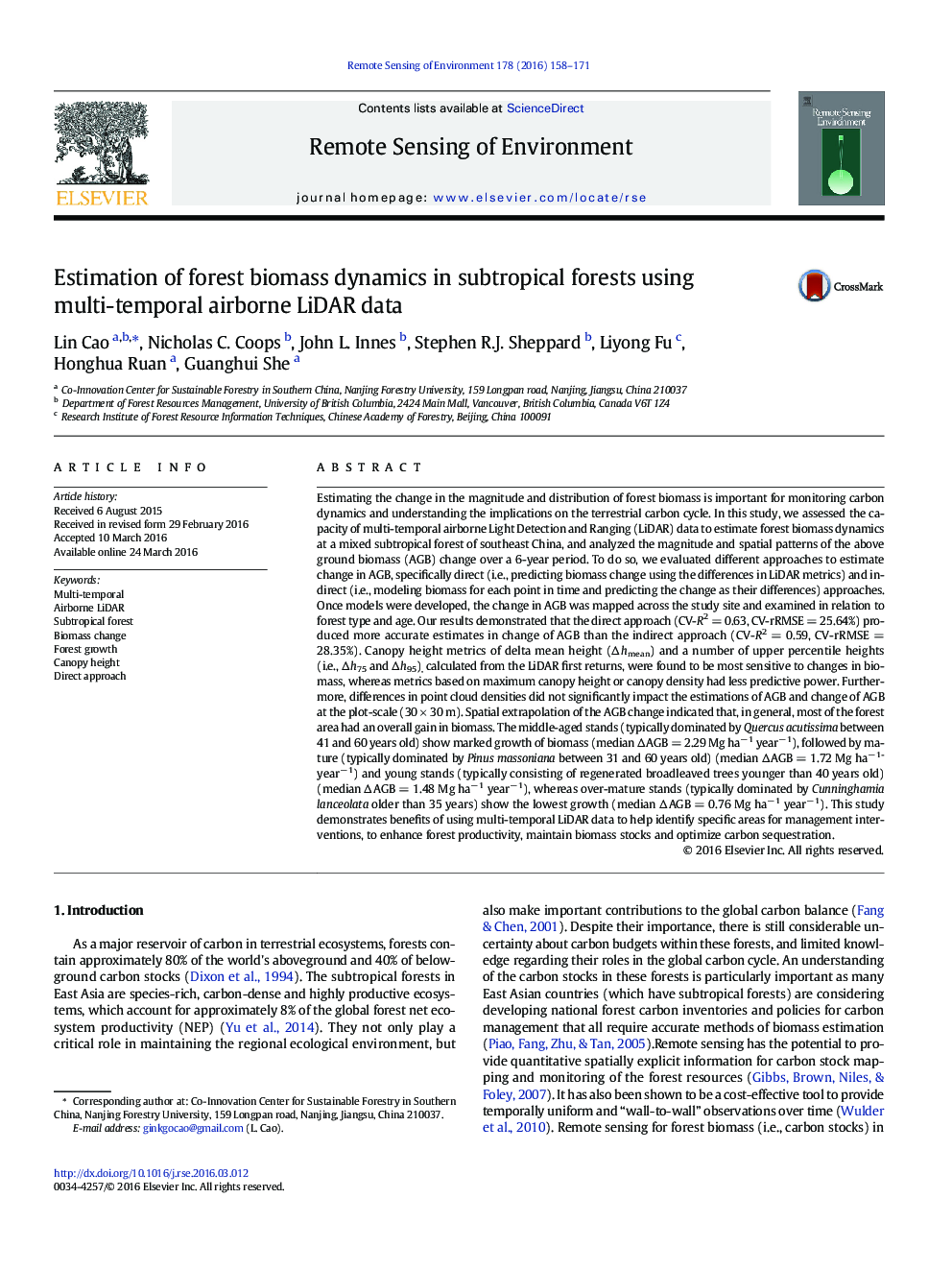| کد مقاله | کد نشریه | سال انتشار | مقاله انگلیسی | نسخه تمام متن |
|---|---|---|---|---|
| 6345396 | 1621222 | 2016 | 14 صفحه PDF | دانلود رایگان |
عنوان انگلیسی مقاله ISI
Estimation of forest biomass dynamics in subtropical forests using multi-temporal airborne LiDAR data
دانلود مقاله + سفارش ترجمه
دانلود مقاله ISI انگلیسی
رایگان برای ایرانیان
کلمات کلیدی
موضوعات مرتبط
مهندسی و علوم پایه
علوم زمین و سیارات
کامپیوتر در علوم زمین
پیش نمایش صفحه اول مقاله

چکیده انگلیسی
Estimating the change in the magnitude and distribution of forest biomass is important for monitoring carbon dynamics and understanding the implications on the terrestrial carbon cycle. In this study, we assessed the capacity of multi-temporal airborne Light Detection and Ranging (LiDAR) data to estimate forest biomass dynamics at a mixed subtropical forest of southeast China, and analyzed the magnitude and spatial patterns of the above ground biomass (AGB) change over a 6-year period. To do so, we evaluated different approaches to estimate change in AGB, specifically direct (i.e., predicting biomass change using the differences in LiDAR metrics) and indirect (i.e., modeling biomass for each point in time and predicting the change as their differences) approaches. Once models were developed, the change in AGB was mapped across the study site and examined in relation to forest type and age. Our results demonstrated that the direct approach (CV-R2 = 0.63, CV-rRMSE = 25.64%) produced more accurate estimates in change of AGB than the indirect approach (CV-R2 = 0.59, CV-rRMSE = 28.35%). Canopy height metrics of delta mean height (â hmean) and a number of upper percentile heights (i.e., â h75 and â h95), calculated from the LiDAR first returns, were found to be most sensitive to changes in biomass, whereas metrics based on maximum canopy height or canopy density had less predictive power. Furthermore, differences in point cloud densities did not significantly impact the estimations of AGB and change of AGB at the plot-scale (30 Ã 30 m). Spatial extrapolation of the AGB change indicated that, in general, most of the forest area had an overall gain in biomass. The middle-aged stands (typically dominated by Quercus acutissima between 41 and 60 years old) show marked growth of biomass (median â AGB = 2.29 Mg haâ 1 yearâ 1), followed by mature (typically dominated by Pinus massoniana between 31 and 60 years old) (median â AGB = 1.72 Mg haâ 1 yearâ 1) and young stands (typically consisting of regenerated broadleaved trees younger than 40 years old) (median â AGB = 1.48 Mg haâ 1 yearâ 1), whereas over-mature stands (typically dominated by Cunninghamia lanceolata older than 35 years) show the lowest growth (median â AGB = 0.76 Mg haâ 1 yearâ 1). This study demonstrates benefits of using multi-temporal LiDAR data to help identify specific areas for management interventions, to enhance forest productivity, maintain biomass stocks and optimize carbon sequestration.
ناشر
Database: Elsevier - ScienceDirect (ساینس دایرکت)
Journal: Remote Sensing of Environment - Volume 178, 1 June 2016, Pages 158-171
Journal: Remote Sensing of Environment - Volume 178, 1 June 2016, Pages 158-171
نویسندگان
Lin Cao, Nicholas C. Coops, John L. Innes, Stephen R.J. Sheppard, Liyong Fu, Honghua Ruan, Guanghui She,